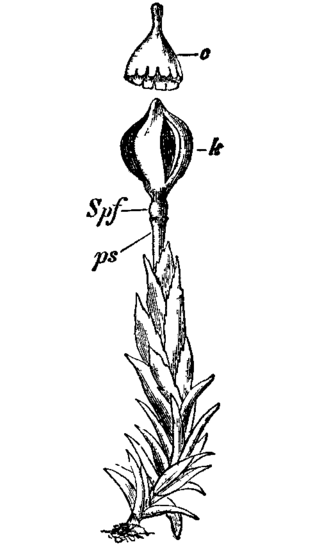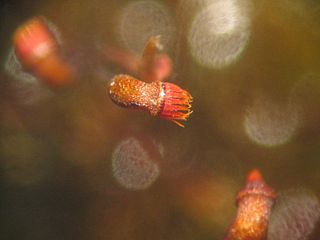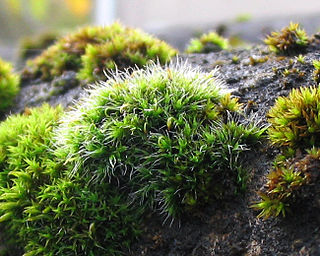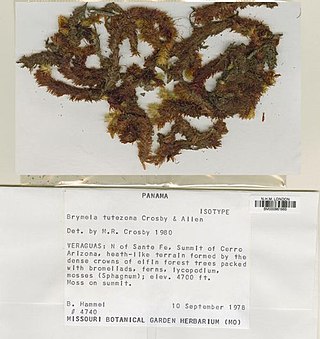
Andreaeaceae is a family of mosses which includes two genera, Andreaea, containing about 100 species, and the genus Acroschisma. The Andreaeaceae prefer rocky habitats ranging from tropical to arctic climates, on which they form tufted colonies, typically with reddish to blackish shoots. The capsules lack the peristome mechanism and dehisce longitudinally to release the spores, resulting in a paper-lantern appearance.

The Bryopsida constitute the largest class of mosses, containing 95% of all moss species. It consists of approximately 11,500 species, common throughout the whole world.

Grimmiales is an order of mosses in the subclass Dicranidae. It comprises four families: Grimmiaceae, Ptychomitriaceae, Seligeriaceae, and Saelaniaceae.

Sphagnopsida is a class of mosses that includes a single subclass Sphagnidae, with two orders. It is estimated it originated about 465 million years ago, along with Takakia. The order Sphagnales contains four living genera: Ambuchanania, Eosphagnum, and Flatbergium, which counts four species in total, and Sphagnum which contains the rest of the species. The extinct Protosphagnales contains a single fossil species.
Acritodon nephophilus is a species of moss in the family Sematophyllaceae. It is endemic to Mexico, where it is known only from two locations in the Sierra Madre de Oaxaca of Oaxaca state. Its natural habitat is subtropical or tropical moist lowland forests. It is threatened by habitat loss. Conservation efforts for this species have difficulty protecting local populations due to insufficient attention and legislation regarding preservation of moss species.
Acritodon is a genus of moss in the family Hypnaceae.

Brymela tutezona is a species of mosses in the family Pilotrichaceae. It is endemic to Panama. Its natural habitat is subtropical or tropical moist lowland forests. It is threatened by habitat loss.

Pottiales is an order of mosses in the subclass Dicranidae.
Lepidopilum grevilleanum is a species of moss in the Pilotrichaceae family. It is endemic to Ecuador. Its natural habitat is subtropical or tropical moist lowland forests. It is threatened by habitat loss.
Leucoperichaetium eremophilum is a species of moss in the Grimmiaceae family. It is endemic to Namibia. Its natural habitat is subtropical or tropical dry shrubland. It is threatened by habitat loss.
Mamillariella geniculata is a species of moss in the family Leskeaceae. It is endemic to Russia, where it is an endangered species known from only five to seven locations in the Russian Far East. It grows in deciduous forest habitat which is threatened by development.
Renauldia lycopodioides is a species of moss in the family Pterobryaceae. It is endemic to Tanzania, where it is known from only two locations and is considered an endangered species. It grows on tree branches in forested habitat. It is threatened by deforestation.
Taxitheliella richardsii is a species of moss in the family Pylaisiadelphaceae. It is endemic to Borneo where it is confined to Sarawak. Its natural habitat is subtropical or tropical dry forests. It is threatened by habitat loss.
Andreaeobryum, the Mossy Cowl Moss, is a genus of moss with a single species Andreaeobryum macrosporum, endemic to Alaska and western Canada. The genus is placed as a separate family, order and class among the mosses.

Bryales is an order of mosses.

Encalyptales is an order of mosses in subclass Funariidae. It contains a single family.

Timmia is a genus of moss. It is the only genus in the family Timmiaceae and order Timmiales. The genus is named in honor of the 18th-century German botanist Joachim Christian Timm.

Bryaceae is a family of mosses.
Distichophyllum carinatum is a species of moss in the family Daltoniaceae. It is native to Europe and Asia, where it has a disjunct distribution. It is known to occur in Germany, China, and Japan. It is also known from Austria and Switzerland, but it may be extinct there today. It is very uncommon where it still occurs, growing in only four locations. It is listed as an endangered species by the International Union for Conservation of Nature.
William Russel Buck is an American bryologist.









